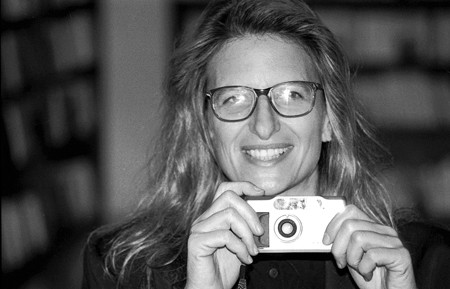
By Trilby Goouch
Blogs Editor
Annie Leibovitz, one of the most famous portrait photographers of our time, has transformed the world of editorial content with her characteristic narrative and creative approach. I find her particularly fascinating; similar to Bill Cunningham, she’s able to function in a commercial, glamorous world while pursuing her passion; take one look at her and you’d be surprised she works in such a materialistic industry.

Annie Leibovitz grew up, as she calls it, “living through a lens”; she attributes her interest in photography to frequent family road trips in which she was exposed to diverse landscapes, city scenes and unique context. She began taking photos with a small 35 mm camera, which allowed her to get up close and personal with her subjects. If you look at her earliest work, it’s fluid and natural; her candid shots make even the slouchiest posture or wrinkled face look both beautiful and graceful.

Her first stint in photography began at Rolling Stone magazine in the 1970s. The easy-going, live-in-the-moment atmosphere of the times is evident in her photos.
Leibovitz’s photographic work began as very spontaneous. The photos she documented while touring with the Rolling Stones, such as a shot of Keith Richards sprawled across the floor, are a testament to her creative freedom. She makes the photographic process look effortless, and yet she captures these incredible shots that are full of thought and attention to detail.

The best part of photography, she noted in the documentary Life Through A Lens, is “you become a part of it”; her subjects frequently note that she photographs in a way that makes you forget she’s there.
After attending rehab for drug addiction in the late 1970s , Leibovitz took on a more commercial, “glitzy” role at Vanity Fair. Her once intimate, candid photography evolved into “slice of life” photography with a focus on celebrity. She began doing “set up photographs”, relating her content to the subject. One of her most famous examples is of Bette Middler lying in a bed of roses to promote her film, The Rose. Others include the band Fleetwood Mac laying on a bed that was meant to reflect the many affairs that they had with one another.

She famously shot Whoopi Goldberg bathing in milk, which she designed to convey Goldberg’s coming out of “white” Hollywood. Her context is simple and narrative, with each photo telling a story. She incorporates a sense of humour and irony in her photos as well, with each portrait “humanizing” celebrity.

Magazine editors covet her work, describing her as efficient, assertive, focused and demanding. Yet when you watch her interact with her subjects, she is both easy-going and personable.
Nowadays, Leibovitz’s work is characteristically larger-than-life, a stark contrast to her original photography. Each year her photographs seem to get more and more extravagant as do the budgets. However it’s this creative, commercial quality that creates such a buzz amongst subjects and magazine readers.
It’s easy to tell a Leibovitz photo apart from the rest; her photos have a fairy-tale, make-believe quality that makes them a feast for the eyes.

Next time you’re browsing through a fashion magazine or Vanity Fair, keen an eye out for Leibovitz’s work. Her photographs are moving and inspiring, giving you a perspective that you won’t find anywhere else. You can also preview her work in the book Annie Leibovitz at Work.
All final editorial decisions are made by the Editor(s)-in-Chief and/or the Managing Editor. Authors should not be contacted, targeted, or harassed under any circumstances. If you have any grievances with this article, please direct your comments to journal_editors@ams.queensu.ca.
